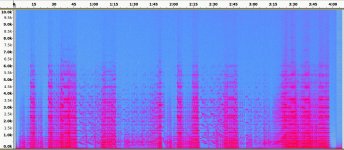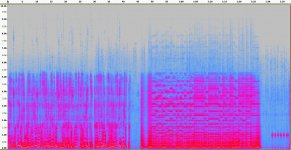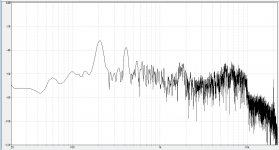And rapidly fading stations get rapidly varying bandwidth. No, for normal purposes superhets are better. Regen sets are fine for playing with, or when you need something cheap and not very cheerful.
Speak for yourself. It's the best AM tuner that I've ever built!
Many of the Armstrong AM tuners, superhets of course, used Q multipliers based around a remote cut-off pentode to do much the same thing. Quite useful, really.
Many of the Armstrong AM tuners, superhets of course, used Q multipliers based around a remote cut-off pentode to do much the same thing. Quite useful, really.
Q multipliers don't give varying bandwidth with signal strength. They can suffer from poor skirt selectivity, which is why they are more commonly found in older and cheaper communications receivers.
They do when they are part of an AGC. Armstrong made a big thing of it back in the day. Automatic selectivity or something like that.
I have an ST3 which uses the same concept. Works rather well.
I have an ST3 which uses the same concept. Works rather well.
I had made a regenerative receiver with tubes, which is published in another forum, in this site. Also, they have better audio quality than the medium AM standard receiver, but this project demonstrated myself that a well designed superhet can also give good audio signals. Yesterday, I listened to it about 8 hours, and is pleasant, much more than the SS I have constructed several years ago, using TDA1220 and TDA 7211 for FM front end.
I have taken also, a couple of short videos to show how the screen regulator works (much better and lower noisier than a VR tube), and how with some few volts, the AGC can control a strong local signal, and with the antenna shorted.
In fact, can anybody tell me if the ferrite rod is an antenna or an aerial, and which is the difference between them?
many thanks for reading and comment here.
I have taken also, a couple of short videos to show how the screen regulator works (much better and lower noisier than a VR tube), and how with some few volts, the AGC can control a strong local signal, and with the antenna shorted.
In fact, can anybody tell me if the ferrite rod is an antenna or an aerial, and which is the difference between them?
many thanks for reading and comment here.
Last edited:
An antenna is the whole system, the supporting structure, feed cable and conducting element.
The aerial is just the conducting element.
Hope that helps you!
Automatic regeneration is very interesting to me 😀 . I like the control it give.
The aerial is just the conducting element.
Hope that helps you!
Automatic regeneration is very interesting to me 😀 . I like the control it give.
Additionally, 'aerial' is only really used when the antenna is outdoor, or on a supporting structure.
Banfield sounds British. Are you a British Argentine?
Banfield sounds British. Are you a British Argentine?
No, I'm argentine, and grandson of italians.
Banfield is the town I was born, and actually I still live there. My nick, "Osvaldo de Banfield" stands for "Osvaldo from Banfield", in spanish.
Ing Edward Banfield was an engineer who work in the installation of the railroad, and a station has his name, which after him, the entire town received his name. People says that he never known the area, and never stay there.
See also:
https://en.wikipedia.org/wiki/Edward_Banfield_(railroad_engineer)
https://en.wikipedia.org/wiki/Banfield,_Buenos_Aires
Banfield is the town I was born, and actually I still live there. My nick, "Osvaldo de Banfield" stands for "Osvaldo from Banfield", in spanish.
Ing Edward Banfield was an engineer who work in the installation of the railroad, and a station has his name, which after him, the entire town received his name. People says that he never known the area, and never stay there.
See also:
https://en.wikipedia.org/wiki/Edward_Banfield_(railroad_engineer)
https://en.wikipedia.org/wiki/Banfield,_Buenos_Aires
Ah, OK. Incidentally, what sort of sidebands do you get on AM broadcasts in Argentina?
Here in the UK it is very hard to find anything that exceeds 5kHz or so.
Here in the UK it is very hard to find anything that exceeds 5kHz or so.
I can't tell you exactly, because I lack of instrumental needed to make some affirmation. But aurally, it sounds much better that my older with IC's. The high frequencies of the S's, for example, are clearly defined, and almost as good as an FM transmission, particularly when speaking is a woman.
The T filter in the detector, is a key in this point, as defines much more accurately than the IF channel, because it doesn't move (bandwidth) with AGC changes.
The T filter in the detector, is a key in this point, as defines much more accurately than the IF channel, because it doesn't move (bandwidth) with AGC changes.
Some of the tuners built with ICs in the '70s could only manage 2kHz 😱 .
You could record the line output of your tuner with an audio interface and have a look at the spectrogram in Audacity.
As an example, the image attached shows a spectrogram of an 84 year old 78rpm record, with a recorded bandwidth of 6kHz.
You could record the line output of your tuner with an audio interface and have a look at the spectrogram in Audacity.
As an example, the image attached shows a spectrogram of an 84 year old 78rpm record, with a recorded bandwidth of 6kHz.
Attachments
May be. When I made such a receiver, I used ceramic resonators and IFT's rescued from other circuits, and I never checked its BW. It was about 20 years ago, and in the middle I learned much more than I knew to this moment.
AM BW appears to be 10KHz here.
Some time ago, radio stations used the odd tenth's of KHz, say, 710, 750, 790KHz. But from about a decade, also even tent's were raising, 720, 740, 760KHz and so on.
AM BW appears to be 10KHz here.
Some time ago, radio stations used the odd tenth's of KHz, say, 710, 750, 790KHz. But from about a decade, also even tent's were raising, 720, 740, 760KHz and so on.
Last edited:
There is no difference. 'Aerial' was the original English name used, as a shortened version of 'aerial wire' - which means the wire put up in the air. 'Antenna' is now the preferred word used in electronic engineering. Most lay people continue to say 'aerial'. They mean exactly the same thing.Osvaldo de Banfield said:In fact, can anybody tell me if the ferrite rod is an antenna or an aerial, and which is the difference between them?
Strictly speaking, the antenna or aerial is just the part which actually interacts with the electromagnetic field; the rest is the 'support' or 'mast'. However, common usage calls the whole thing standing outside a transmitter building an 'aerial'.
So we are in agreement?
Antenna: Radiating and passive elements including supporting structure and feed cable.
Aerial: Radiating element, or radiating and passive elements.
It's a bit pedantic, but who am I to refuse the opportunity to posture my vocabulary? 😀
Antenna: Radiating and passive elements including supporting structure and feed cable.
Aerial: Radiating element, or radiating and passive elements.
It's a bit pedantic, but who am I to refuse the opportunity to posture my vocabulary? 😀
Thank you. Langford Smith in his book "Radiotron" always refer it as aerial, but as doesn't mention the ferrite rod nor the quad, I didn't know how to call it right way.
I would refer to the ferrite rod as an 'antenna'. When I think of aerials, I think of radiating elements. I would not consider a magnetic loop antenna to be an aerial.
Hope that helps you 🙂 .
Hope that helps you 🙂 .
Here's a spectrogram of a recording of the BBC World Service on 198kHz that I made in 2011. The upper limit is just over 5kHz.
I shouldn't have sold that JVC tuner in hindsight. It was pretty decent, going over some of the recordings I made with it 🙁 .
I shouldn't have sold that JVC tuner in hindsight. It was pretty decent, going over some of the recordings I made with it 🙁 .
Attachments
- Home
- Source & Line
- Analogue Source
- High (Audio) Quality AM Tuner


